This post may contain affiliate links. If you use these links to buy something we may earn a commission. Thanks.
Living in a drought-prone area comes with plenty of “dry shade” space. This is a collection of the best drought-tolerant and shade-loving ground covers.
Hardy plants such as these are also low maintenance and pleasing to the eyes. From vibrant foliage to delicate blooms, you’ll transform the shaded corners of your garden into lush, inviting retreats with any of these choices.
Related: 24 Best Edible Ground Covers for Shade

Regardless of having a break from the sun, shaded slopes are often very dry areas, and several plants below are also perfect for erosion control, too.
Any drought-resistant plant needs a little help getting established before it will thrive on its own. For at least the first year, provide a few deep waterings when the soil has dried.
For each ground cover, you’ll learn about the main functions of each ground cover, what climate each is best for, and where you can acquire the plants.
Many plants are available at local nurseries or from plant swap groups. If, however, you have trouble finding the ideal plants you want—seeds are often available from small businesses on Etsy with free shipping.
Otherwise, Nature Hills Nursery offers a variety of plants in containers. On their groundcover page, use their filtered search to find other options:
- on the side panel under “zones” check your growing zone.
- under “sun exposure” check full shade
From there, you’ll sift through a small number of options to find which ones tolerate drought.
Before planting any of these options check with your local invasive plant council or regional extension office for guidance on plants that may be invasive in your area.
Here are the ground covers that tolerate drought in the shade:
Bigleaf periwinkle (Vinca major)
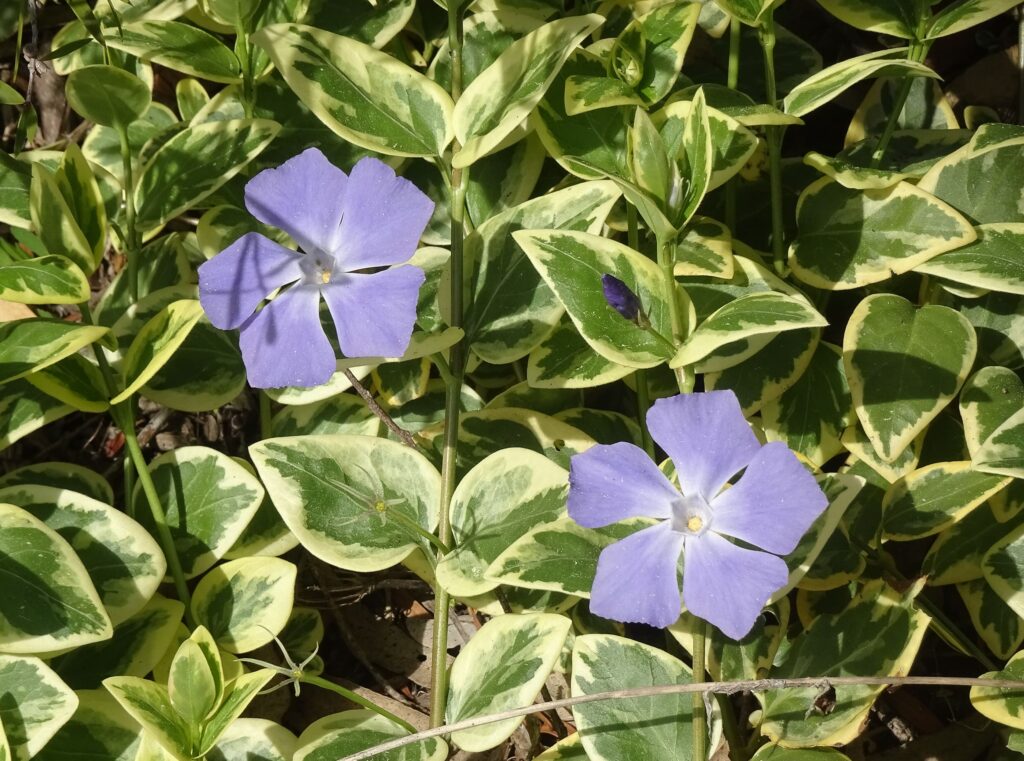
This evergreen vining ground cover grows in all sun levels and is very resilient to dry spells. This vine is often used in “annual” hanging baskets as it beautifully cascades long lengths and withstands quick-drying soils in sun or shade.
In the right climate (zones 7-9) this perennial is evergreen. They flower very well in all but deep shade but are primarily used for erosion control in forest gardens.
- Height: 12-18 inches
- Range: Europe and Africa
- Climate: Zones 7-9
- Functions: Ornamental April to June flowers and vibrant or variegated foliage. Erosion control. Quick ground coverage.
- Light requirements: Full/deep, partial, or no shade.
- Soil preferences: Dry or moist soil and is drought resistant. Suitable for light or heavy soils, including heavy clay.
Seeds and various flower colors are available here and solid green or variegated foliage are available in containers here.
Pennsylvania sedge (Carex pensylvanica)
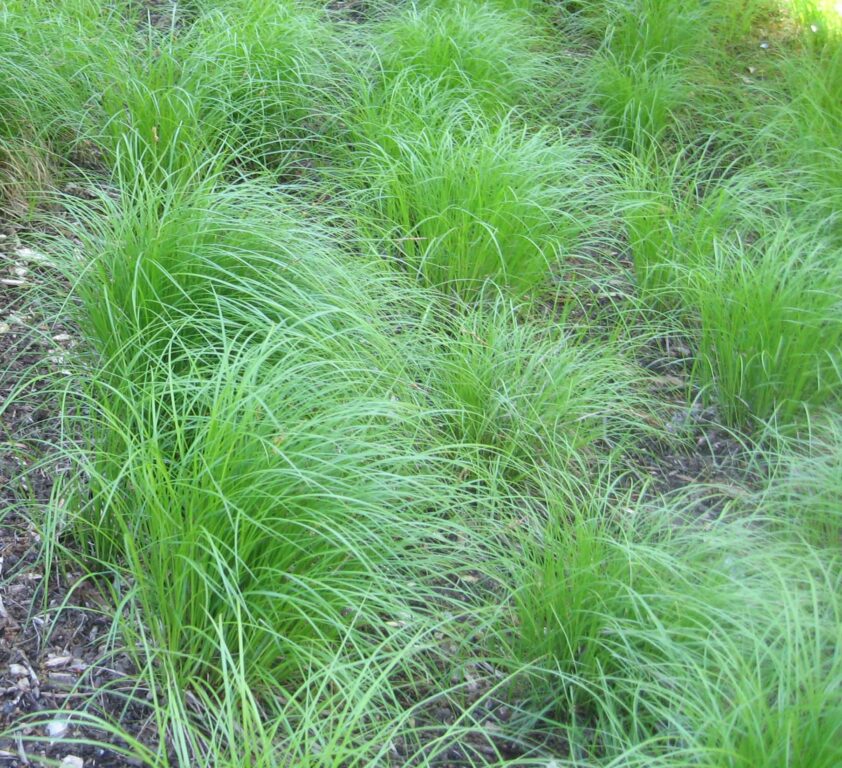
This grassy-looking evergreen native attracts wildlife—in good ways—and stabilizes the soil whether it’s moist or dry. With a bit of mulch, you’ll be able to set and forget it after establishing.
- Height: 6-12 inches
- Range: North America
- Climate: Zones 4-8
- Functions: A perfect ground cover for dry shade to prevent erosion and emptiness, or lawn replacement for heavy-shaded areas.
- Light requirements: Full/deep shade to partial shade or full sun.
- Soil preferences: Moist soil and tolerates drought.
This sedge is available here (currently at 17% off).
Bristleleaf sedge (Carex eburnea) hardy to zones 2-8 is also an option or alternative if you’d like variety or a colder climate option.
Carpet Bugleweed (Ajuga reptans)

Also known as Bugleweed, it forms a dense mat with spikes of blue flowers. It has small creeping foliage and keeps snug to the ground.
Bugleweed is a popular ground cover as it thrives in several conditions including dry shade.
- Height: 4-8 inches.
- Range: Europe, Asia, North Africa.
- Climate: Zones 3-10
- Functions: Attracts bees and butterflies. Edible leaves and shoots. Cute carpeting ground coverage. Medicinal benefits. Ideal for rock gardens, erosion control, low growing ground coverage, and usefulness.
- Light requirements: Full/deep shade to partial shade.
- Soil preferences: Moist or wet soil. Tolerates droughts.
Plants and seeds are available here.
Rose Of Sharon (Hypericum calycinum)
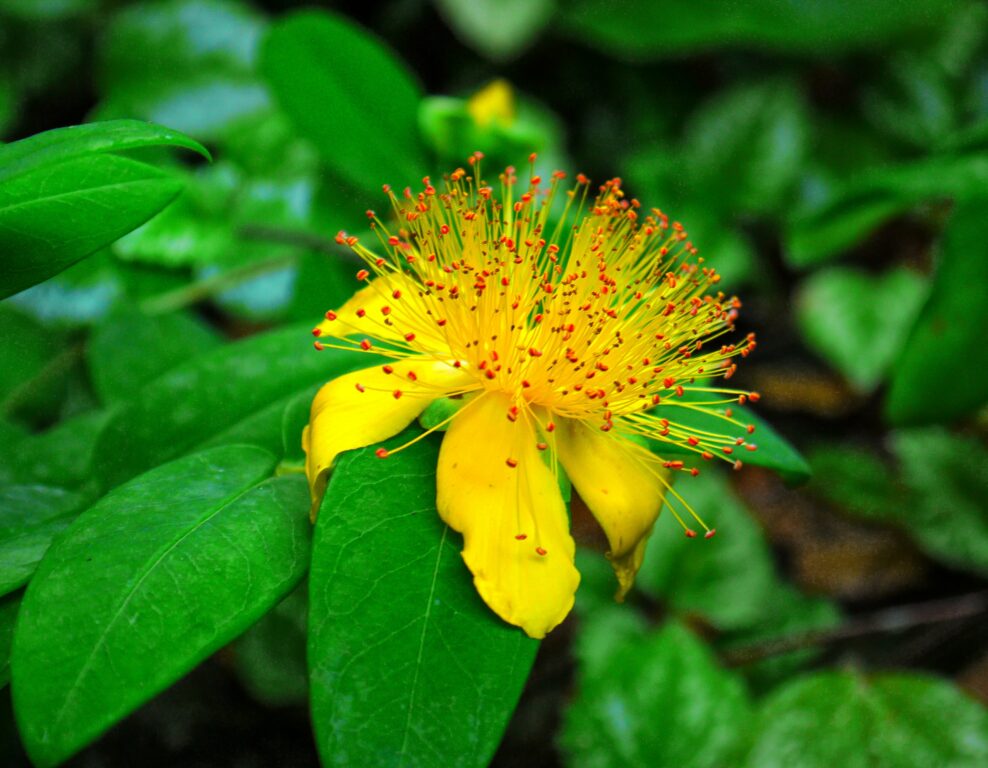
If you’re looking for a showy and low-growing ornamental you’ll love the Rose of Sharon. Rose of Sharon is also a shade lover and even thrives in a full shade position. You’ll get more flowers in bright or partial shade, but either way, it will survive droughts.
- Height: 12-18 inches
- Range: Asia
- Climate: Zones 5-10
- Functions: Used as an ornamental semi-evergreen ground cover. Prevents erosion, is gorgeous when cascading, and attracts butterflies.
- Light requirements: Deep, full, semi, or no shade.
- Soil preferences: Moist or dry soil and drought tolerant. Suitable for heavy clay.
Nature Hill’s Nursery offers two types of Rose of Sharon (and calls them St. Johns Wort). If you prefer to grow from seed, plenty of options with free shipping are available here.
Japanese Spurge (Pachysandra terminalis)
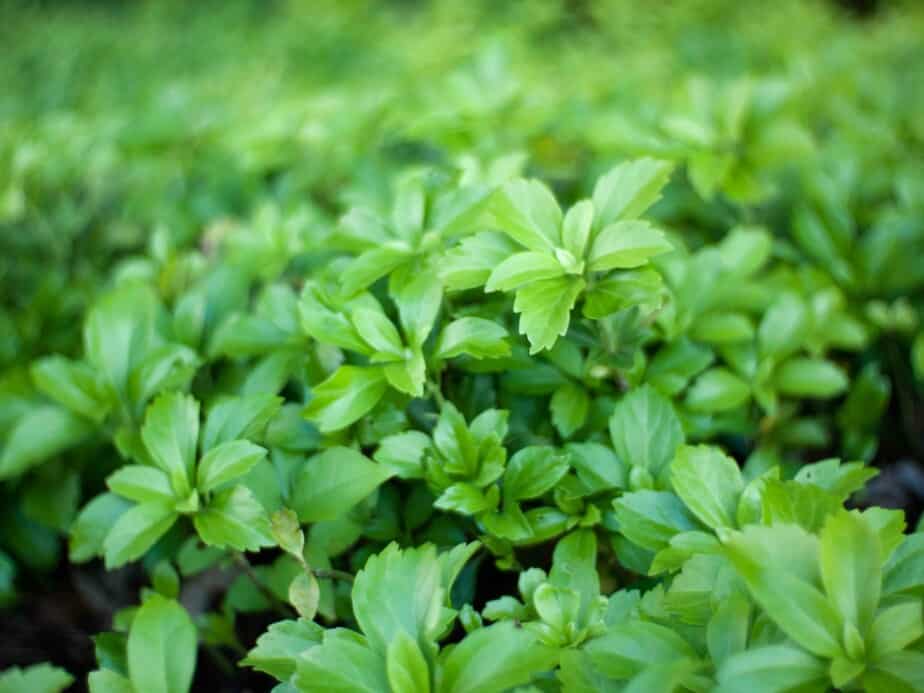
Japanese spurge offers a vibrant and eye-catching texture. It thrives in deep shade or partial shade and offers a dense bright green in darker spaces. While it grows fast, it isn’t invasive beyond the shade.
- Height: 2-8 inches
- Range: Asia
- Climate: Zones 4-8
- Functions: Best used under established shrubs or trees to control erosion, cover exposed soil, or fill gaps around rocks.
- Light requirements: Full/deep shade to partial shade.
- Soil preferences: Dry or moist soil and tolerant to drought.
From April to May, you’ll also enjoy the scent of inconspicuous flowers.
Japanese spurge seeds and cuttings are available here and plants are available here.
Bigroot Geranium (Geranium macrorrhizum)

Most geraniums are full sun lovers but this variety grows well in deep shade or partial shade. Bigroot geranium grows fast, overtakes weeds, and forms a dense ground cover. Once established it persists beyond dry summers.
- Height: 3 feet
- Range: Europe
- Climate: Zones 4-8
- Functions: Ornamental flowers from June to August. Used as a scent confuser for pest prevention. The strong fragrance is used to make oils and potpourri. Deer resistance.
- Light requirements: Full/deep shade to partial shade.
- Soil preferences: Moist soil dry soil and drought tolerant.
When shopping for seeds or plants be sure you’re selecting the correct geranium that has shade tolerance.
Checkerberry (Gaultheria procumbens)
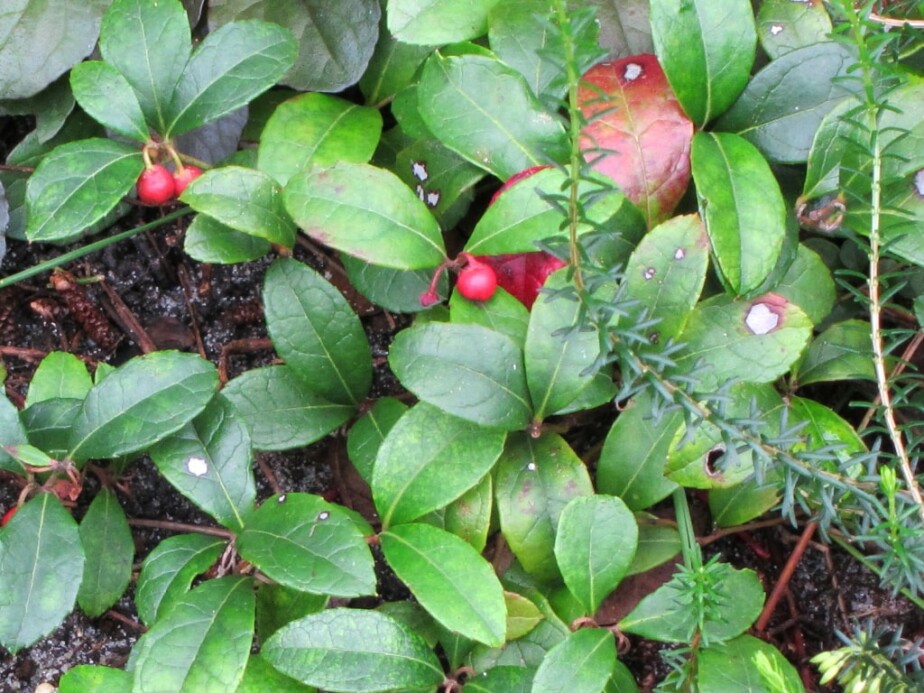
Native to Eastern North America, I can confirm that these berries are as fragrant as chewing wintergreen gum. The flavor, however, is bland and like chewing styrofoam.
Once established this plant survives tough droughts, although it does prefer moisture—perfect for the rest of the year when not experiencing drought.
- Height: 3 inches
- Range: North America
- Climate: Zones 3-6
- Functions: Edible fruit and leaves. Fragrance. Low ground coverage.
- Light requirements: Full/deep shade to partial shade.
- Soil preferences: Moist or dry soil and tolerates drought.
These little leaves and berries make a great cup of tea but grow at a medium rate.
Plant loads of seeds to fill a space.
Lesser Periwinkle (Vinca minor)
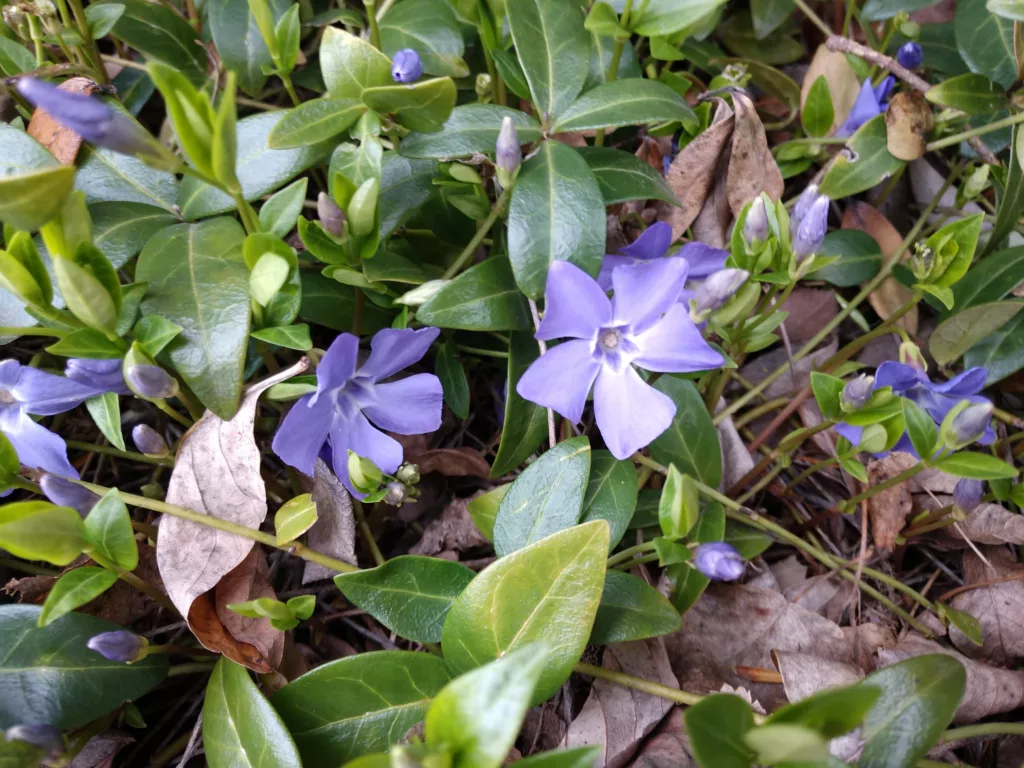
Also called Periwinkle, this is a semi-evergreen ground cover with blue-purple flowers. It’s a fast-growing erosion controller and a popular choice for dry shady spaces.
Although popular, it may be considered invasive or naturalizing in your area.
- Height: 6 inches
- Range: Europe and Asia
- Climate: Zones 4-9
- Functions: Ornamental flowering from April to May with season-round attractive foliage. Erosion controlling ground cover for rock gardens, food forests, steep slopes, shady areas, and borders.
- Light requirements: Full/deep shade to partial shade, or no shade.
- Soil preferences: Moist or dry soil and tolerates drought. Suitable for various soil types including heavy clay.
Plants are available here and seeds are here. Ordering seeds offers pink and other flower colors, but a container allows for quicker establishment.
Buffalo Grass (Stenotaphrum secundatum)
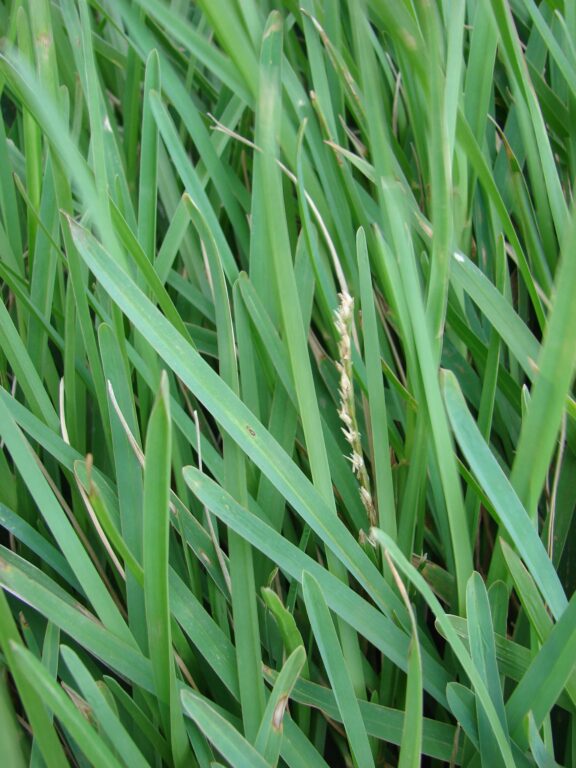
Buffalo grass is very drought tolerant when established and left at longer heights. If you’re looking to fill a spot where grass doesn’t grow, with grass, then buffalo grass will do the job. It’s often used in pastures or to prevent soil loss under trees or near the sea as it tolerates maritime exposure.
- Height: 35 inches
- Range: North & South America
- Climate: Zones 7-12
- Functions: A perfect ground cover for dry shade to prevent erosion and emptiness, or lawn replacement for shaded areas. Conserving soil.
- Light requirements: Full/deep shade to partial shade or no shade.
- Soil preferences: Moist soil and tolerates drought.
Many local areas will have buffalo grass available. Here’s one place that offers it.
Chinese Bramble (Rubus tricolor)

Rubus tricolor grows climbing, trailing, or cascading. This ground cover will outcompete others—so it’s best to grow this only with larger trees or shrubs to prevent any wanted plants from being overtaken.
- Height: 6-12 inches
- Range: Asia
- Climate: Zones 6-9
- Functions: Fast-growing and vigorous ground cover. Edible fruits.
- Light requirements: Full/deep shade to partial shade.
- Soil preferences: Moist soil and tolerates drought. Suitable for heavy clay.
This shade-loving raspberry is available at a variety of nurseries. Here’s one in Washington.
Azure bluet (Houstonia caerulea)

A very low-growing native ground cover, with pretty blue flowers that attract bees, butterflies, and other pollinators.
- Height: 3-6 inches
- Range: North America
- Climate: Zones 3-8
- Functions: Edibel flowers and leaves.
- Light requirements: Full, partial, or no shade.
- Soil preferences: Moist or dry soil with good drainage and tolerates drought.
Seeds for this ground cover are available here, otherwise, local seed swappers or nurseries may sell this too.
Creeping indigo (Indigofera hendecaphylla)

For those in tropical climates, this legume is widely used in food forests, otherwise known as agroforestry. It grows in all sunlight levels and is particularly drought-resistant.
- Height: 12-18 inches
- Range: Africa & Asia
- Climate: Zones 10-12
- Functions: Nitrogen fixer. Soil stabilizer. Ground cover. Green manure. Attracts wildlife.
- Light requirements: Full/deep, partial, or no shade.
- Soil preferences: Dry or moist soil and persists through drought. Grows well in a range of soils from light to heavy.
Creeping indigo may be invasive in some areas, do check with your local councils before sourcing the plant.
Final thoughts
Dry and drought-prone shade is a tough spot to grow plants. With the right plants, however, the space can absolutely thrive!
If you’d like more zone-focused options for colder climates, you may find other dry-shade options in these lists:
- Best Zone 3 Ground Covers for Shaded Areas (With Pics)
- Best Zone 4 Ground Covers for Shade (with Pics)
- Best Zone 5 Ground Covers for Shade (With Pics)
Recent Posts
There’s no shortage of full-sun ground covers for zone 4 climates! Each plant in this list can withstand the frigid temperatures and also enjoy the hot sun in summer. Full sun means that a plant...
There's no shortage of full sun ground covers, not even in zone 3! Zone 3 climates offer hot but short-lived summers and very cold winters. So each plant in this list can withstand the frigid...
